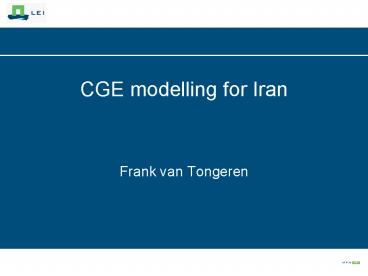CGE modelling for Iran - PowerPoint PPT Presentation
1 / 24
Title:
CGE modelling for Iran
Description:
Energy price reform. Exchange rate unification. Food subsidies. The Iran ... raises exports, but leads to Dutch disease problems (depreciation exchnage rate) ... – PowerPoint PPT presentation
Number of Views:53
Avg rating:3.0/5.0
Title: CGE modelling for Iran
1
CGE modelling for Iran
- Frank van Tongeren
2
Computable General Equilibrium models
- Stylized (but useful) 123 model
- CGE model Iran much more detail (Wednesday)
- GTAP global model, much detail
3
CGE
- Economy-wide view
- All activities
- Circular flow of income and expenditures
- Consistency (accounting, theory)
- Ingredients
- Theory, Data, (computer), policy
4
Data
- Data for CGE models arranged in Social Accounting
Matrix (SAM) - System of National Accounts (SNA)
5
A stylized SAM
6
Dimensions for Iran SAM, Jensen Tarr, 2003
- Activities
- 43 sectors
- Factors
- Labour, capital, land (specific to agriculture),
natural resource (specific to oil sector) - Institutions
- 20 Households, by rural-urban and by income
- 1 government
- Benchmarked to 1999/2000
7
Theory
- Neo-classical principles
- Producers maximize profits (or min.cost)
- Consumers maximize utility
- Constant returns to scale in production and
perfect competition on all markets
8
The flow of output in a typical CGE model
Output
Primary factor composite
Composite intermediates
9
The flow of output in a typical CGE model
Output
Primary factor composite
Composite intermediates
capital
labour
land
imported
domestic
10
The flow of output in a typical CGE model
Exports
Domestic market
Output
Primary factor composite
Composite intermediates
capital
labour
land
imported
domestic
11
The flow of output in a typical CGE model
Consumption demand
Exports
Domestic market
Intermediate input demand
Output
Primary factor composite
Composite intermediates
capital
labour
land
imported
domestic
12
Production assumptions Cost Minimizing Behavior
- Behavioural equations are derived from an
economic decision problem - Choose cost minimizing input mix, given the
technical characteristics of production - Cost function C(w, q) min ?wi xi st. q
f(x) - ?C(w, q)
- Factor demand ----------- xi(q, w)
(Shephards lemma) - ?wi
13
Assumptions Separability
- Assume separable, constant returns to scale
production function - Separability e.g., of primary factors from
intermediate inputs means that - optimal mix of land, labor, and capital is
invariant to price of intermediates - elasticity of substitution between any primary
factor and intermediates is the same (zero in
this case). - too restrictive for some purposes (eg.,
energy-labor substitution is not equal to
energy-capital substitution). - can be relaxed if full matrix of substitution
elasticities is known.
14
The flow of output in a typical CGE model
Output
Leontief
Primary factor composite
Composite intermediates
Armington
capital
labour
land
imported
domestic
15
The nested production function
Output
Value added
Intermediate inputs
Imported interme- diates
16
Final Production - Leontief
- Production function
- share of value-added/intermediates in
output from the base data.
17
Final Production - Leontief
- Production function
- share of value-added/intermediates in output
from the base data. - Derived demands
18
Value-added Nest CES
- Production function
Primary production factord
Value added
19
Value-added Nest CES
- Production function
- Derived demands
- The coefficient SVA is the cost share and PVA the
price index
Proportional to QVA constant returns to scale
20
Value-added Nest CES
- Derivation of price index Cost minimization
under CES (simplified form)
From the first order conditions
Raise to the power
And sum over all e, to obtain
marginal cost marginal revenue
21
Linearizing the CES - Input Demand more
convenient
- Two input case (capital letters levels lower
case letters change) - Input demand
Linearized
- Note expansion and substitution effects
- Note no initial levels and shares in linearized
factor demand eqn. gt convenient for calibration!
22
The Iran CGE model (cont.)
- Standard small-open economy (SOE) model
- But
- 20 household groupsd for poverty analysis
- Elaborate oil sector modelling
- Crude oild, 7 refined sectors
23
The Iran CGE model (cont.)
- Policies considered
- Tariffication of NTBs
- Tariffication uniform tariff
- Energy price reform
- Exchange rate unification
- Food subsidies
24
The Iran CGE model (cont.)
- Main findings
- Tariffication uniform tax increases income of
poorest 20 income increase rural 11 indcrease
urban - This is mainly due to lump-sum transfers from
govmnt to hhlds - Lump-sum transfers far better in raising poor
hhlds income than market intervention through
commodity taxes/subsidies (leakages, degressivity
of indirect subs.) - Removing domestic energy subsidies raises
exports, but leads to Dutch disease problems
(depreciation exchnage rate)































